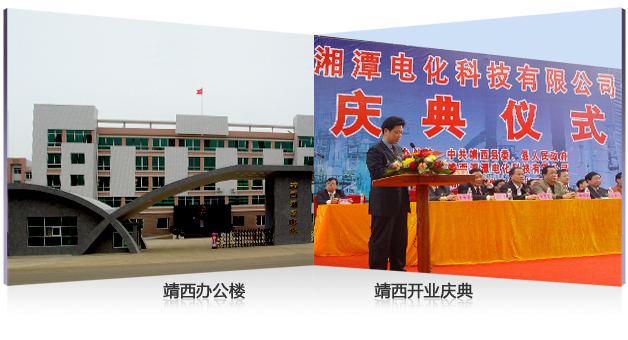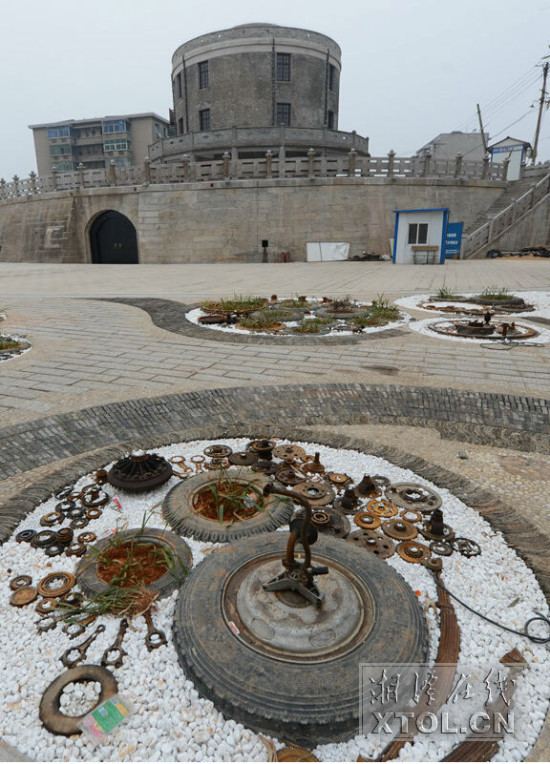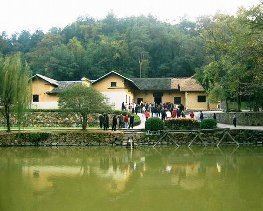Population 707,783 (2000) Mayor Wu Qixiu (???) | Area 5,006 km2 | |
 | ||
Country Peoples Republic of China | ||
Map of Xiangtan
Xiangtan (Chinese: 湘潭; pinyin: Xiāngtán; Wade–Giles: Hsiang-tan) is a prefecture-level city in Hunan province, China. The hometowns of several founding leaders of the Chinese Communist Party, including Mao Zedong, Liu Shaoqi, and Peng Dehuai, are in the Xiangtan prefecture, as well as the hometowns of Qing dynasty painter Qi Baishi and scholar-general Zeng Guofan.
Contents
- Map of Xiangtan
- Xiangtan
- Geography
- Etymology
- Pre Ming Dynasty
- Ming and Qing Dynasties
- Population
- Religion
- Geography and climate
- Administrative divisions
- Economy
- Transportation
- Tourism
- Sports
- Colleges and universities
- Notable locals
- References

Xiangtan
Geography

Xiangtan is located on the lower reaches of the Xiang River.
Etymology
The name "Xiangtan" is derived from local geography, though there are several explanations for its origin vary somewhat in details. In any case, "Xiang" (湘) refers to the Xiang River, while "Tan" (潭) is a Chinese term that means "deep pool", specifically one produced by a moving current or waterfall; "Tan" in rivers generally are places where the current eddies. One reasoning is that the city was built by a large eddy in a bend of the Xiang River, and was thus called "Xiang-Tan". Another more likely story says the name originated in the Xiangzhou Eddy, today called the Zhao Eddy (昭潭). The Zhao Eddy is an ancient whirlpool located in a deep section of the Xiang River near the traditional border between Xiangtan and Changsha, and is named for King Zhao of Zhou, who is said to have died there.
Pre-Ming Dynasty
Relics from the Daxi culture indicate that people inhabited the Xiangtan area in the 3rd millennium BC. Shang Dynasty bronzewares have been found in the region, as well as tombs from the Warring States period. During the Three Kingdoms Period, the kingdom of Eastern Wu built a city in the west of modern Xiangtan City and organized the Hengyang Commandery (衡陽郡) around it. In 749, the Tang Dynasty organized the area as Xiangtan County, centered at modern Yisu River (易俗河). By the time of the Northern Song Dynasty, Xiangtan's good access to both land and water trade routes had established it as the major commercial center of the region.
Ming and Qing Dynasties
Xiangtan prospered throughout the Ming Dynasty and Qing Dynasty upon an economic foundation of trading in rice and traditional Chinese medicinal ingredients, and was sometimes referred to as "Little Nanjing" or "Golden Xiangtan". Prior to the Second Opium War, Xiangtan was a central transfer point for import and export goods going to and from ports in Canton, Shanghai, and Wuhan, supported by approximately 200,000 inhabitants.
Population
As of 2010, it had 2,748,552 inhabitants, of whom 1,779,960 lived in the built-up area (2 urban districts plus Xiangtan county). Together with the four adjoining urban districts of Zhuzhou, its built-up area is home to 2,586,948 inhabitants. In 2007, the city was named China's top ten livable cities by Chinese Cities Brand Value Report, which was released at the 2007 Beijing Summit of China Cities Forum.
Religion
Since 1937.07.01 thi city is the episcopal see of the Apostolic Prefecture of Xiangtan 湘潭 (中文) / Siangtan / Siangtanen(sis) (Latin), a pre-diocesan Latin rite Catholic jurisdiction, on territory split off from the then Apostolic Vicariate of Changsha 長沙) (now its Metropolitan). It is exempt, i.e. directly dependent on the Holy See (not part of any ecclesiastical province) and its missionary Roman Congregation for the Evangelization of Peoples; no statistics available.
It is vacant, under an apostolic administrator, since decades, having had only the following Apostolic Prefects of Xiangtan 湘潭 (all Roman Rite) :
Geography and climate
Xiangtan has a humid subtropical climate with long, hot summers, and cool to cold, cloudy, damp winters with occasional snow flurries. Within its administrative area, the annual mean temperature ranges from 16.7 to 17.4 °C (62.1 to 63.3 °F), with the coolest month being January, which averages 4.1 °C (39.4 °F), and the hottest July, at 29.7 °C (85.5 °F).
Administrative divisions
The city of Xiangtan has direct jurisdiction over 2 districts (区 qu), 2 county-level cities (市 shi), and 1 county (县 xian) :
Economy
In 2006, Xiangtan's nominal GDP was ¥42.2 billion (US$6.2 billion), a year-on-year growth of 13.2% from the previous year. Its per capita GDP was ¥15,455 (US$2,265).
Xiangtan is famous for its production of Lotus seed and Soy sauce. People in Xiangtan like to chew areca nut (槟榔; pinyin: bīngláng), though the area itself doesn't grow them. Most raw areca nut fruits are from Hainan and processed locally. The history of consuming areca nut dates back to 400 years ago, when people chewed it for pandemic prevention. Nowadays, it is quite common to see people chewing areca nut in Hunan. In 2003, the sales revenue of areca nut industry in Xiangtan had reached ¥800 million.
Transportation
Xiangtan is well connected by roads, river and rail. There is a shuttle bus service connecting to Changsha Huanghua International Airport.
Tourism
Many people continue to visit Shaoshan, Xiangtan to visit the birthplace of Mao Zedong, the former chairman of the Chinese Communist Party and the leader of the People's Republic of China from 1949-1971.
Sports
Professional tennis player Peng Shuai was born and trained in Xiangtan. Xiangtan Stadium was the home to Bayi Football Team of the Chinese Football Association Jia League (now Chinese Super League) from 2002 to 2003.
Colleges and universities
This is a list of institutions with full-time bachelor programs in Xiangtan:
Notable locals
Xiangtan is the birthplace of:
